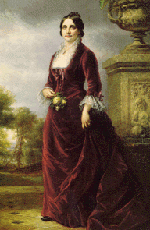|
| |
| |
Art for the President's House--An Historical Perspective
This passion for the past affected the residents of the Executive Mansion. "I love this house for the associations that no other could have," exulted First Lady Lucy Hayes in 1878, the year she acquired Martha Washington's portrait. Eager to commemorate the house's occupants, Mrs. Hayes consulted A.R. Spofford, the Librarian of Congress, and decided to complete the historical collection of presidential portraits begun by Healy before the Civil War. The very selection of a librarian as an art adviser underscores Mrs. Hayes' desire to pursue documentation rather than art. Spofford's attempts to acquire Stuart portraits of John Adams and Thomas Jefferson from their families failed, so he soon embarked on a predictable course, commissioning copies to fill the void left by the unavailability of original life portraits. He first secured the services of the Boston painter Edgar Parker, an accomplished copyist of Gilbert Stuart, to replicate portraits of Adams, Madison, and Monroe. President and Mrs. Hayes, whose impatience to complete the series was known, were approached by Eliphalet Frazer Andrews, the painter of Martha Washington's portrait and of an earlier portrait of President Hayes. Andrews wanted to produce impressive canvases suited to the scale of the East Room. He undertook full-length posthumous portraits--including images of Jefferson and Jackson--based on careful research. And he carried the replication process to further extremes by using earlier portraits by other artists and even photographs as models to make not one copy but multiple images of individual sitters. Less appealing to 20th-century eyes than the originals, such copies must be viewed in the spirit that motivated their creation. At that time works were added to the White House collection because of the eminence of their sitters, not the eminence of their creators. That copies could satisfy was the result of a once commonplace feature of artistic education. Painters routinely learned to paint by copying the work of established artists. Imitation was encouraged until a would-be painter demonstrated mastery over the essentials of his technique. Mrs. Hayes did not select Andrews to paint her own image, however. When the National Women's Christian Temperance Union (WCTU) offered to fund a suitable memorial to her, she settled on a portrait and made a more artistic choice of painters. He was Daniel Huntington, then president of the National Academy of Design and one of the most fashionable portraitists of his generation. The likeness, presented to the White House in 1881, was hung just as the Hayes Administration ended. After President Hayes left the White House he followed his wife's example, selecting Huntington to execute a companion piece. Mrs. Hayes was the first presidential wife to have her portrait painted for the White House collection, and the Hayeses' portraits are the first pair--President and First Lady--to enter the collection in reasonable proximity. It is not mere chance that their large-scale and grand manner poses beg for comparison with the more memorable Stuart Washington and its belated companion by Andrews. The Hayeses' slightly grandiose portraits, as well as their White House memorabilia and copious scrapbooks of clippings, suggest that this presidential couple sought for themselves the same exalted place in White House history that they had helped secure for George and Martha Washington. Mrs. Hayes, who along with her husband had agreed to ban liquor at the White House, was widely admired, even hailed as representing "the new woman era." The First Lady and her contemporaries, including the WCTU donors of her portrait, seem to have endorsed the tradition begun by Julia Tyler of building a portrait collection. During the eight years between the Hayes Administration and that of Benjamin Harrison, the collection changed little beyond the addition of presidential portraits. This was partially the result of circumstance. Shot by an assassin, James A. Garfield died in September 1881, only months after taking office. His successor, Chester A. Arthur, was preoccupied with a major redecoration of the White House. And Grover Cleveland so openly disliked the lack of privacy at the White House that he used it primarily for official functions, preferring to live in his nearby summer retreat.
![[Back one page]](/media/gif/leftarro.gif)

![[Continue]](/media/gif/continue.gif)
President and First Lady | Vice President and Mrs. Gore |